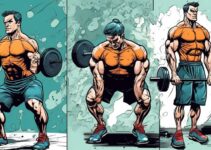Boosting testosterone through targeted cardio workouts can be a challenging yet rewarding endeavor. You may be surprised to learn that the right kind of cardio can help you elevate your testosterone levels naturally. But with so many workout options available, how do you know which ones are the most effective for optimizing your testosterone production? It's not just about breaking a sweat; it's about choosing the right type, timing, duration, intensity, and frequency of cardio workouts. If you're looking to take your fitness routine to the next level and maximize your testosterone, this discussion is sure to provide you with the insights you need to achieve your goals.
Key Takeaways
- High-intensity interval training (HIIT) and resistance-based cardio exercises are the best types of cardio workouts for boosting testosterone levels.
- Timing and duration of cardio workouts are important, with morning workouts and cardio after strength training being optimal.
- Monitoring heart rate and maintaining the ideal range can stimulate testosterone production during cardio workouts.
- Proper nutrition, adequate sleep, and incorporating recovery strategies are essential for maximizing the benefits of cardio on testosterone levels.
The Benefits of Cardio Workouts for Testosterone
Engaging in regular cardio workouts can significantly boost your testosterone levels, promoting overall health and well-being. When it comes to muscle growth, cardio exercises play a crucial role. Cardio workouts help in increasing blood flow and oxygen delivery to your muscles, which aids in the repair and growth of muscle tissues. This improved circulation also enhances the delivery of nutrients to your muscles, which is essential for their development and recovery. Additionally, cardio exercises promote the release of growth hormone, which further supports muscle growth.
Testosterone and endurance are closely linked, and engaging in cardio workouts can positively impact both. Research has shown that regular aerobic exercise can lead to an increase in testosterone levels, which is beneficial for improving endurance. Higher testosterone levels can enhance your body's ability to build and repair muscle tissue, ultimately contributing to improved endurance during physical activities. This hormone also plays a vital role in increasing red blood cell production, which in turn improves oxygen delivery to the muscles, enhancing endurance and overall athletic performance.
Best Types of Cardio Workouts for Testosterone
To optimize testosterone levels through cardio workouts, it is essential to focus on high-intensity interval training (HIIT) and resistance-based cardio exercises. High-intensity interval training (HIIT) involves short bursts of intense exercise followed by brief recovery periods. This type of workout has been shown to significantly boost testosterone levels. During high-intensity intervals, your body requires a substantial amount of energy, leading to an increase in anabolic hormone production, including testosterone. HIIT can be performed through various activities such as sprinting, cycling, or jump rope.
In addition to HIIT, resistance-based cardio exercises, such as weightlifting, are also highly effective for enhancing testosterone levels. Resistance training, especially using compound movements like squats, deadlifts, and bench presses, stimulates the release of testosterone and growth hormone. These exercises place a significant demand on the body, leading to muscle damage and subsequent repair, which triggers an increase in testosterone production. It's important to incorporate both aerobic and anaerobic exercises into your cardio routine to maximize the benefits for testosterone levels.
Timing and Duration of Cardio Workouts for Testosterone
When should you schedule your cardio workouts for maximum testosterone-boosting benefits, and what is the optimal duration for these sessions? The timing and duration of your cardio workouts can significantly impact their effects on testosterone levels. To maximize the testosterone-boosting benefits, consider the following factors:
- Optimal timing:
- Morning: Engaging in cardio workouts in the morning can be particularly beneficial for testosterone levels. Testosterone levels are typically higher in the morning, and exercising during this time can further enhance its production.
- Post-strength training: Incorporating cardio workouts after strength training sessions can also be advantageous for testosterone levels. Strength training can deplete glycogen stores, and engaging in cardio post-strength training can effectively tap into fat stores for energy, potentially supporting testosterone production.
- Workout duration:
- 30-45 minutes: Aim for a moderate duration of 30-45 minutes for your cardio workouts. Prolonged cardio sessions lasting over an hour can lead to an increase in cortisol levels, which may counteract the testosterone-boosting effects of the workout.
- Interval training: Consider incorporating interval training into your cardio sessions. Short bursts of high-intensity exercise followed by periods of rest or lower-intensity exercise can be an efficient way to boost testosterone levels without excessively elevating cortisol.
Optimizing the timing of your cardio workouts, such as scheduling them in the morning or after strength training, and maintaining a moderate duration while possibly incorporating interval training, can help maximize the testosterone-boosting benefits of your cardiovascular exercise routine.
Intensity and Frequency of Cardio Workouts for Testosterone
For optimal testosterone-boosting effects, it is essential to carefully consider the intensity and frequency of your cardio workouts. When it comes to intensity, high-intensity, short-duration workouts have been shown to have a more significant impact on testosterone levels compared to long duration, moderate intensity exercises. High-intensity interval training (HIIT) is a popular example of this type of workout, involving short bursts of intense exercise followed by brief periods of rest or lower intensity activity. This type of workout not only helps in boosting testosterone but also improves cardiovascular health and promotes fat loss.
On the other hand, long duration, moderate intensity exercises such as steady-state cardio may not have the same testosterone-boosting effects as high-intensity workouts. However, they still offer benefits for overall health and fitness. It's important to strike a balance in your workout routine, incorporating both high-intensity and moderate-intensity workouts to reap the full range of benefits.
| Intensity & Duration | Testosterone Effects | Other Benefits |
|---|---|---|
| High Intensity, Short Duration | Boosts testosterone levels | Cardiovascular health improvement, fat loss |
| Long Duration, Moderate Intensity | May not have significant testosterone-boosting effects | Overall health and fitness benefits |
Understanding the impact of different intensities and durations of cardio workouts on testosterone levels can help you tailor your exercise routine to maximize the hormonal benefits while also addressing other fitness and health goals.
Precautions and Tips for Cardio Workouts to Boost Testosterone
You should carefully monitor your heart rate during cardio workouts to optimize testosterone-boosting effects. Maintaining a heart rate of around 70-80% of your maximum heart rate is ideal for stimulating testosterone production. To achieve this, consider using a heart rate monitor to ensure you are within the target range throughout your cardio sessions.
- Nutrition tips
- Consume an adequate amount of healthy fats, such as those found in avocados, nuts, and olive oil, as they play a crucial role in hormone production, including testosterone.
- Ensure you are getting enough protein in your diet to support muscle recovery and growth, as well as testosterone production. Aim for a mix of animal and plant-based protein sources to cover all essential amino acids.
- Recovery strategies
- Prioritize quality sleep to support testosterone production and optimize recovery. Aim for 7-9 hours of uninterrupted sleep each night.
- Incorporate active recovery strategies, such as light stretching, yoga, or leisurely walks, to facilitate muscle recovery and reduce the potential negative impact of excessive cardio on testosterone levels.
Frequently Asked Questions
Can Specific Cardio Workouts Target and Increase Testosterone Levels in Certain Muscle Groups?
Specific cardio workouts can indeed target and increase testosterone levels in certain muscle groups. The key lies in the timing and intensity of the cardio sessions. By strategically incorporating high-intensity interval training (HIIT) or resistance-based cardio exercises, you can stimulate a more significant testosterone response in targeted muscle groups. However, it's crucial to allow for adequate recovery periods between workouts to maximize the hormonal benefits and avoid overtraining.
Are There Any Dietary or Supplement Recommendations to Enhance the Effects of Cardio Workouts on Testosterone Levels?
To enhance the effects of cardio workouts on testosterone levels, consider dietary recommendations and supplement suggestions. Research shows that a diet rich in nutrients like zinc, vitamin D, and omega-3 fatty acids can support healthy testosterone levels. Additionally, certain supplements like D-aspartic acid and ashwagandha may have potential benefits. It's crucial to consult with a healthcare professional before adding any new supplements to your regimen to ensure they align with your specific health needs.
How Does Age and Fitness Level Impact the Effectiveness of Cardio Workouts for Boosting Testosterone?
As you age, your fitness level can impact how effective cardio workouts are for boosting testosterone. Generally, higher fitness levels can lead to greater testosterone increases. For optimal results, aim for moderate intensity cardio sessions of around 30-45 minutes, 3-5 times per week. However, it's essential to tailor your workouts to your individual fitness level and age, as overtraining can have the opposite effect on testosterone levels.
Can Incorporating Strength Training Into a Cardio Workout Routine Further Enhance Testosterone Production?
Incorporating strength training into your cardio routine can significantly impact testosterone production. The combination of both cardiovascular and resistance exercises can enhance the overall intensity of your workout, leading to greater testosterone release. The scientific evidence suggests that this approach may have a more pronounced effect on testosterone levels compared to solely engaging in cardio exercises. Therefore, integrating strength training into your cardio regimen could further optimize your testosterone production.
Are There Any Potential Long-Term Effects or Risks Associated With Consistently High-Intensity Cardio Workouts for Testosterone?
Consistently engaging in high-intensity cardio workouts may have potential long-term risks for hormone regulation, including testosterone levels. Overtraining and extreme endurance exercises could lead to a condition called exercise-induced hypogonadism, impacting hormone production. In some cases, this may result in reduced testosterone levels. It's important to balance your cardio routine with adequate rest and recovery to mitigate the potential long-term effects on testosterone and hormone regulation.
Conclusion
In conclusion, incorporating effective cardio workouts into your routine can significantly enhance testosterone production. By engaging in high intensity interval training, sprints, or cycling, you can maximize your hormone levels. Timing and duration, as well as frequency and intensity, play crucial roles in optimizing the benefits of cardio for testosterone. Remember to listen to your body, and consult with a fitness professional to tailor your workouts for the best results.



